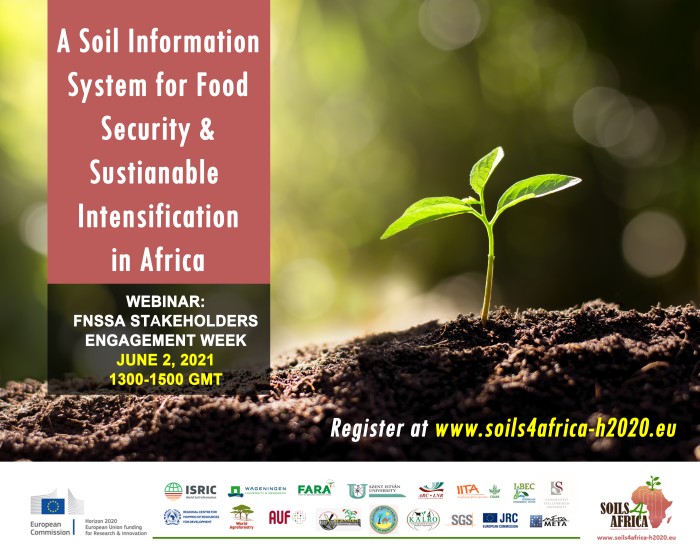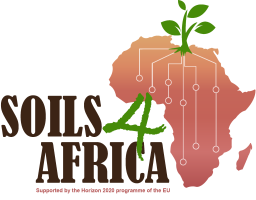<< Back to News
Soils4Africa webinar at FNSSA Stakeholders Week: Summary of questions and responses

Following are the questions received at the event, and corresponding responses from the Soils4Africa project. Some of the them could be answered directly, at the webinar, other could not be due to lack of time.
Watch highlights from the webinar here: https://tinyurl.com/s4a-fnssa-highlights
Usability
-
Will smallholder farmers be able to directly use the SIS? If not, what will be the pathway through which data from the SIS will factor into decision-making at the smallholder farm level?
20,000 topsoil samples are not enough for farm-level assessments. But thanks to clever digital soil mapping technology, we can provide gridded soil information at a spatial resolution of 250m x 250m (or even finer). However, that does not necessarily mean that the system is applicable for decision-making at smallholder fields. The question is one of accuracy; whether the data is accurate enough to make predictions at the level of farmers’ fields. We will not get there at the end of this project. By then, the SIS may be applicable at a regional scale, i.e. villages or larger, for the development of farmer-relevant applications and policy support. The results of S4A can also serve as a baseline at continental scale against which to assess future soil changes.
However, we will be working on building a community of practitioners who, by following the standardized methodologies of sample collection and lab analysis, will help produce more accurate data at national level, with possible applicability at farm level, over time.
LUCAS Soil too was originally set up as a baseline against which to assess future changes, with 22,000 sample locations. Expansions in 2018 increased the number of locations to 40,000. Just like Soils4Africa for the AU, LUCAS Soil was initially set up as an EU-level system. It now has application in and buy-in from most member countries. With that, LUCAS Soil grew in terms of data collection and data granularity. With this its relevance to more local level decision-making has increased, apart from continental/regional level decision-makings. We hope to see that happening for Soils4Africa as well. That requires commitment and investment (buy-in) from national level actors.
-
Internet connectivity in many countries is limited. Thus, an downloadable/offline version of the SIS will be very useful. Will there be one?
This is currently not a very high priority. In the first years the main users of the SIS will be policy makers who are expected to access the SIS from their computers in their offices. However, over time the applicability of the SIS may widen (see above) and at that time an off-line version becomes more relevant.
-
Will it be possible to integrate the data/insights offered by Soils4Africa with existing apps/services offering agricultural information to farmers?
The SIS will be a basic soil information system providing different kinds of soil data. Providers of agricultural information/intelligence services to farmers can certainly tap into the SIS for the soil information that they need for their (broad-level) applications. The SIS should be a ground layer for such services. The SIS will not provide soil information detailed and accurate enough for farm-specific applications; its scope is national to continental.
Clarifications and specific suggestions
-
The importance of Sulphur as a limiting nutrient is being increasingly recognised. Will the samples be analysed for Sulphur?
Yes, as per the S4A methodology, the samples will be analysed for Sulphur.
-
Will the SIS methodology allow for successive sampling at the same 20,000 points, or will the sampling locations be expanded?
The S4A sampling design is flexible and can be expanded to include more locations in future sampling rounds. For monitoring purposes, the original sampling points could be revisited but this is not mandatory. A good strategy for monitoring is to revisit a subset of the original points and supplement this subset with newly selected points. Expansion could even be country-specific. Ideally, countries adopt the S4A sampling design for future sampling rounds (when the purpose is monitoring). At the same time, soil data collected with a different sampling design for a different purpose could be useful to supplement the monitoring data. Key, then, would be that the soil samples are collected using similar field protocols and analyzed with similar lab methods for compatibility. In this way, we can work towards a relevant time series of soil data and a solid set of methods to analyze such data to infer soil changes over time.
-
Are the Soils4Africa sampling protocols also considering soil management histories in order to help understand which management methods are helping conserve/improve soil quality?
Current land, soil and water management practices are observed, but no data will be gathered on historical land use and land and soil management practices. For a limited number of reference sites we will do so, to evaluate whether this provides relevant information. At a more general level, soil quality will be evaluated for the various farming systems, which also reflects land and soil management information to an extent.
-
Will it be possible to access the point data, so that derived products can be developed?
Point data resulting from S4A will be openly accessible.
-
Arrangements should be made in advance committing governments/organisations to carry out data collection every 10 years or so. Will that be done for Soils4Africa?
We are going to develop a sustainability strategy for the SIS, as part of which we will definitely work towards such arrangements.
-
What are the advantages of building a continental-scale Soil Information System, as opposed to helping governments develop national-level SISs?
A continental SIS
allows for continental level assessments of status of soil quality because of use of standard methodologies for data collection and analysis. It provides insights in the status of the soils of the entire continent, and helps to raise awareness. At the same time, an important purpose is to develop a strategy, tools and IT environment that helps national soil institutes to further evolve their own national programs and systems. Helping governments to develop a national SIS is definitely needed
as a national SIS will likely have more applicability within the country.
-
In what way, if at all, will governments be engaged in the process of developing the S4A SIS?
Soils4Africa has received many official expressions of support from national entities. National soil institutes will be engaged in sampling in their territories. We are looking into possibilities to expand the projects with a large scale training program for national soil institutes, to enable them to apply the developed methods and tools at a national level
-
What would be a good way to engage countries with very little experience/capacity/baseline in the area of soil data? Would it be possible to help such countries (referring to Zimbabwe) that do not have their own national soil information systems?
The way Soils4Africa is set up, there isn’t scope to assist individual countries set up soil information systems of their own, or to assist them through capacity building. However, a lot of effort is put in by the Global Soil Partnership to build capacities of national governments in this regard. We will be happy to link up with such efforts and assist these capacity building processes.
-
Will the samples be analysed for micronutrients and biological indicators?
Micro-nutrients will be analysed on all samples. We are currently discussing the possibility of biological analysis of a limited number ofsamples. Once our laboratory protocols are finalised, we will share this information through our website and other communication channels. Please subscribe to our newsletter at
https://www.soils4africa-h2020.eu/news to stay updated.
-
Please do communicate and contact us for soil sampling in Mauritius.
Soils4Africa will carry out sampling in continental Africa. Mauritius is outside the scope of the project. But the standardized methodologies of soil sampling and laboratory analysis developed in the project can be applied to Mauritius as well. We will make these methodologies available in due course. If Mauritius/ Mauritian institutions want to sample the soil by themselves as a contribution to S4A, S4A-compatible sampling locations can certainly be provided.
Soils4Africa in relation to Global Soil Partnership
-
Are there linkages between the Global Soil Partnership and Soils4Africa? Will there be integration of some kind between the two?
Absolutely. ISRIC is leading the Soils4Africa project and is active in the Global Soil Partnership. ISRIC will take care of these links. For instance, for the soil analysis we will follow GLOSOLAN guidance as close as possible. We have also proposed that the Soils4Africa SIS will be a node GLOSIS. And the GSP capacity building programme can help to further strengthen the national institutions to develop their own monitoring programs.
-
How does LUCAS differ from WRB?
LUCAS Soil is a system to measure and monitor soil properties and qualities across the EU. The WRB is a reference system for the classification of soils (that is based on soil profile description and analyses). They serve different purposes and cannot really be compared. The Soils4Africa project aims to classify the soil profile at a limited number of sampling sites using the WRB system. S4A intends to classify soils according to WRB at a number of reference sites
-
Standardized and harmonized methods of soil sample collection and analysis have already been developed under GSP’s GLOSOLAN.
GLOSOLAN is aiming at developing harmonised methods, but this goal has not been achieved yet. Soils4Africa will adhere to GLOSOLAN guidance as much as possible. At the same time, it can help to further develop standardized methods for African soils.


